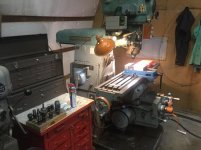steamandsteel
Aluminum
- Joined
- Oct 21, 2017
- Location
- Wichita, KS
Hello,
I've got a Gorton Tracemaster, or at least a Tracemaster ram on a different base, and the hydraulic power feeds are all stuck on rapid traverse. I have tried to no avail to free up the rapid traverse lever to disengage. Everything functioned alright until it was moved out of one shop and into mine. In addition, the table feed doesn't want to engage and gears buzz/grind whenever you try to engage it. Obviously I didn't force it, just lightly tried to engage and immediately stopped to prevent damage.
Here are some pictures of the machine for reference.
Excited to have purchased my first mill!


I've got a Gorton Tracemaster, or at least a Tracemaster ram on a different base, and the hydraulic power feeds are all stuck on rapid traverse. I have tried to no avail to free up the rapid traverse lever to disengage. Everything functioned alright until it was moved out of one shop and into mine. In addition, the table feed doesn't want to engage and gears buzz/grind whenever you try to engage it. Obviously I didn't force it, just lightly tried to engage and immediately stopped to prevent damage.
Here are some pictures of the machine for reference.
Excited to have purchased my first mill!









